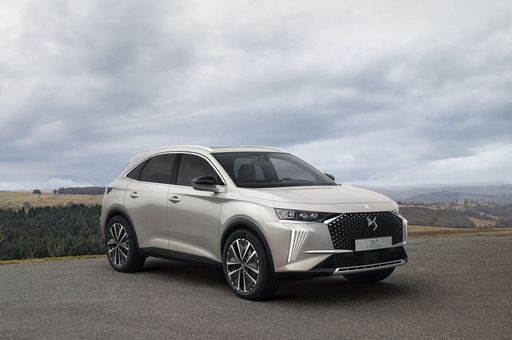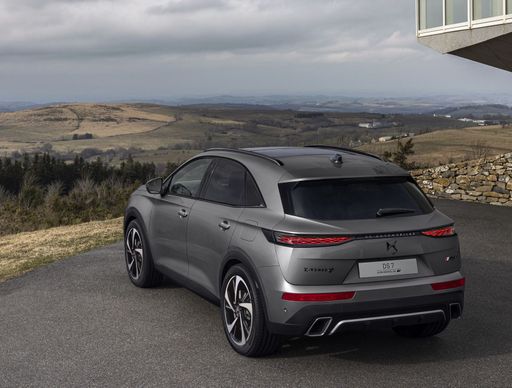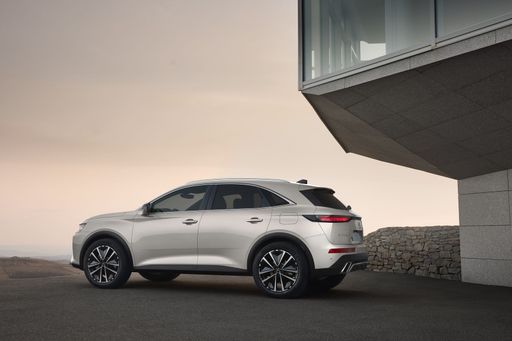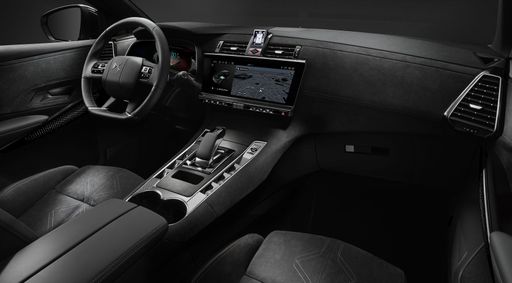DS Automobiles DS 7 VS Renault Trafic Bus – Specs, Efficiency & Price Comparison
Which model is the better choice – the DS Automobiles DS 7 or the Renault Trafic Bus? We compare performance (360 HP vs 170 HP), boot capacity (555 L vs ), efficiency (1.30 L vs 6.80 L), and of course, the price (40300 £ vs 36000 £).
Find out now which car fits your needs better!
The DS Automobiles DS 7 (SUV) is powered by a Diesel or Plugin Hybrid engine and comes with a Automatic transmission. In comparison, the Renault Trafic Bus (Bus) features a Diesel engine and a Manuel or Automatic gearbox.
When it comes to boot capacity, the DS Automobiles DS 7 offers 555 L, while the Renault Trafic Bus provides – depending on what matters most to you. If you’re looking for more power, you’ll need to decide whether the 360 HP of the DS Automobiles DS 7 or the 170 HP of the Renault Trafic Bus suits your needs better.
There are also differences in efficiency: 1.30 L vs 6.80 L. In terms of price, the DS Automobiles DS 7 starts at 40300 £, while the Renault Trafic Bus is available from 36000 £.
Compare all the key specs now and find out which model fits your lifestyle best!
DS Automobiles DS 7
The DS 7 stands out with its striking design and luxurious comfort, making it a true embodiment of French elegance in the SUV segment. Inside, the cabin showcases a blend of high-quality materials and innovative features that cater to both driver and passenger needs. With its impressive road presence and refined driving dynamics, the DS 7 promises a captivating driving experience that doesn't compromise on style.
details @ media.stellantis.com
@ media.stellantis.com
 @ media.stellantis.com
@ media.stellantis.com
 @ media.stellantis.com
@ media.stellantis.com
 @ media.stellantis.com
@ media.stellantis.com
Renault Trafic Bus
The Renault Trafic Bus is a versatile and spacious option for those needing to transport multiple passengers comfortably. With its modern design and practical features, it is well-suited for both business and leisure purposes. Its efficient engine and smooth handling make it a reliable choice for long journeys.
details

|
|
|
|
|
Costs and Consumption |
|
|---|---|
|
Price
40300 - 58500 £
|
Price
36000 - 51900 £
|
|
Consumption L/100km
1.3 - 5.5 L
|
Consumption L/100km
6.8 - 7.2 L
|
|
Consumption kWh/100km
-
|
Consumption kWh/100km
-
|
|
Electric Range
57 - 65 km
|
Electric Range
-
|
|
Battery Capacity
12.90 kWh
|
Battery Capacity
-
|
|
co2
30 - 145 g/km
|
co2
178 - 190 g/km
|
|
Fuel tank capacity
43 - 55 L
|
Fuel tank capacity
80 L
|
Dimensions and Body |
|
|---|---|
|
Body Type
SUV
|
Body Type
Bus
|
|
Seats
5
|
Seats
8
|
|
Doors
5
|
Doors
4
|
|
Curb weight
1651 - 2002 kg
|
Curb weight
2041 - 2340 kg
|
|
Trunk capacity
555 L
|
Trunk capacity
-
|
|
Length
4593 mm
|
Length
5080 - 5480 mm
|
|
Width
1891 mm
|
Width
1956 mm
|
|
Height
1625 mm
|
Height
1973 - 1974 mm
|
|
Payload
398 - 424 kg
|
Payload
730 - 1010 kg
|
Engine and Performance |
|
|---|---|
|
Engine Type
Diesel, Plugin Hybrid
|
Engine Type
Diesel
|
|
Transmission
Automatic
|
Transmission
Manuel, Automatic
|
|
Transmission Detail
Automatic Gearbox
|
Transmission Detail
Manual Gearbox, Dual-Clutch Automatic
|
|
Drive Type
Front-Wheel Drive, All-Wheel Drive
|
Drive Type
Front-Wheel Drive
|
|
Power HP
130 - 360 HP
|
Power HP
110 - 170 HP
|
|
Acceleration 0-100km/h
5.7 - 11.9 s
|
Acceleration 0-100km/h
10.6 - 16.5 s
|
|
Max Speed
195 - 235 km/h
|
Max Speed
161 - 186 km/h
|
|
Torque
300 - 520 Nm
|
Torque
300 - 380 Nm
|
|
Number of Cylinders
4
|
Number of Cylinders
4
|
|
Power kW
96 - 265 kW
|
Power kW
81 - 125 kW
|
|
Engine capacity
1499 - 1598 cm3
|
Engine capacity
1997 cm3
|
General |
|
|---|---|
|
Model Year
2024 - 2025
|
Model Year
2023
|
|
CO2 Efficiency Class
E, B
|
CO2 Efficiency Class
G
|
|
Brand
DS Automobiles
|
Brand
Renault
|
DS Automobiles DS 7
The DS 7: A Luxurious SUV Experience
The DS 7 has firmly established its presence in the luxury SUV segment since its launch. Combining elegant design with cutting-edge technology, it stands out as a symbol of sophistication and performance. This SUV from DS Automobiles is designed to meet the demands of modern drivers seeking a compelling blend of luxury, comfort, and efficiency.
Elegance Meets Performance
The DS 7 is available in various powertrains, including efficient diesel and innovative plug-in hybrid systems. The lineup features the DS 7 BlueHDi 130 Diesel Automatic Front-Wheel Drive, offering a robust 130 HP and a remarkable fuel consumption of just 5.5 L/100 km. For those who crave electrification, the DS 7 E-Tense series includes a range of powerful hybrid options, such as the 225 HP variant, presenting an electric range of 65 km, making it a perfect choice for urban driving.
Advanced Hybrid Technology
Among the most impressive offerings is the DS 7 E-Tense 300 Plugin Hybrid Automatic All-Wheel Drive, which delivers a powerful 300 HP, while maintaining exceptional efficiency. This model can accelerate from 0 to 100 km/h in just 5.9 seconds, showcasing not only its sporty character but also its driveability. The integration of a 1.3 L engine and a battery capacity of 12.9 kWh ensures that it efficiently meets the needs of eco-conscious drivers without compromising on performance.
Luxurious Interior and Comfort Features
Stepping inside the DS 7 feels like entering a realm of pure luxury. The interior is finely crafted with high-quality materials and meticulous attention to detail, offering spacious seating for up to five passengers. The cabin is oriented towards providing a serene driving experience, with a trunk capacity of 555 liters, ensuring ample space for luggage. Moreover, the inclusion of state-of-the-art infotainment features enhances both driver and passenger connectivity.
Safety and Driver Assistance Innovations
Safety is a top priority for DS Automobiles, and the DS 7 reflects this commitment. It is equipped with an array of driver assistance systems, including adaptive cruise control, lane departure warning, and automatic emergency braking. These advanced technologies not only elevate the driving experience but also provide peace of mind, ensuring safer journeys on all roads.
Distinctive Trim Levels to Suit Every Taste
The DS 7 is available in various trims, including the exclusive Collection "Antoine de Saint Exupéry" and elegant Pallas variants. Each trim level is designed to cater to diverse preferences, offering unique styles and additional features to enhance the driving experience. From luxury finishes to high-tech enhancements, there’s a tailored DS 7 for everyone.
A Commitment to Sustainability
With an eye toward environmental responsibility, the DS 7 hybrid models boast impressive CO2 emissions figures, with the E-Tense variants emitting as low as 30 g/km. This commitment to sustainability, combined with high levels of performance, makes the DS 7 a forward-thinking choice in the luxury SUV market.
Conclusion: A Class Apart
In conclusion, the DS 7 encapsulates the essence of luxury and modern innovation in the SUV category. Its stunning design, advanced technologies, and array of powerful engines make it a noteworthy contender for anyone seeking an upscale driving experience. As drivers increasingly prioritize sustainability without sacrificing performance, the DS 7 firmly positions itself to meet these evolving demands.
Renault Trafic Bus
A Glimpse into the Renault Trafic Bus: An Icon of Versatility and Innovation
Amongst the plethora of vans designed for both business and leisure, the Renault Trafic Bus stands out as an exemplar of functionality, innovation, and style. Let's delve into what makes the Renault Trafic Bus a popular choice in the UK and across Europe, particularly focusing on its technical specifications and state-of-the-art features.
Performance Dynamics: Power Under the Hood
The Renault Trafic Bus, a staple in Renault's fleet, is driven by a robust diesel engine configuration with power outputs ranging from 110 PS to a formidable 170 PS. The diesel engines combine efficiency and power, offering torque figures between 300 to 380 Nm, ensuring smooth power delivery and capable load hauling.
Drivers can choose between manual and automatic transmissions, both designed to complement the Trafic's front-wheel-drive system. This flexibility ensures that drivers experience enhanced driving comfort whether they are navigating urban roads or cruising on the motorway.
Efficiency Meets Economy
The Trafic Bus showcases impressive fuel economy with consumption figures ranging from 6.8 to 7.2 litres per 100 kilometres. This efficiency is crucial for businesses aiming to minimise operational costs and for families seeking budget-friendly travel options.
With a generous fuel tank capacity of 80 litres, the Renault Trafic Bus is built to cover long distances with fewer fuel stops, making it an ideal choice for long haul journeys.
Technological Innovations and Comfort
The Trafic Bus isn't just about robust performance. Renault has integrated a suite of technological innovations designed to enhance driver and passenger comfort. Its cabins are equipped with the latest infotainment systems and safety technologies, providing an optimal blend of comfort and convenience.
The various trims, such as Life, Start, Spaceclass, and their respective EDC variants, cater to different needs and preferences, ensuring that customers can find the perfect configuration for their requirements.
Design and Dimensions: Space for Every Purpose
Space and versatility are at the heart of the Trafic Bus design. With its dimensions ranging from a length of 5080 to 5480 mm, and a width of 1956 mm, this vehicle offers ample room for passengers and cargo alike. The height stands between 1973 and 1974 mm, ensuring that even taller individuals can travel comfortably.
With seating for up to eight people and a payload capacity between 730 to 1010 kg, the Trafic Bus can transform seamlessly between a people-mover and a goods carrier.
Environmental Considerations
Renault has engineered the Trafic Bus with environmental responsibility in mind. The CO2 emissions range from 178 to 190 g/km, which, while modest for its class, aligns with the efficiency and performance goals set for this versatile vehicle. The CO2 efficiency class is rated as 'G', offering transparency in its environmental impact profile.
Conclusion: A Leader in Its Class
The Renault Trafic Bus continues to lead its segment through a blend of power, efficiency, and technological advancements. Whether it's for commercial transport or family adventures, the Trafic offers a reliable and adaptable solution, setting a high standard for multi-purpose vehicles.
For those seeking a distinguished blend of utility and comfort, the Renault Trafic Bus emerges as an exceptional choice, promising performance and innovation on every journey.
The prices and data displayed are estimates based on German list prices and may vary by country. This information is not legally binding.
